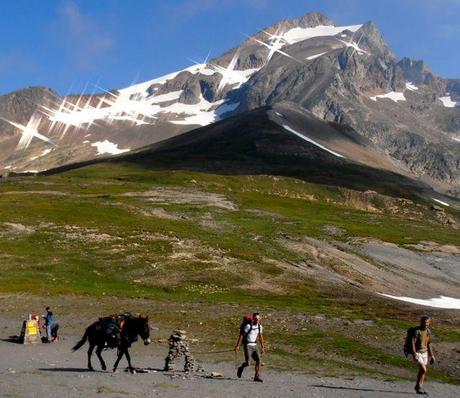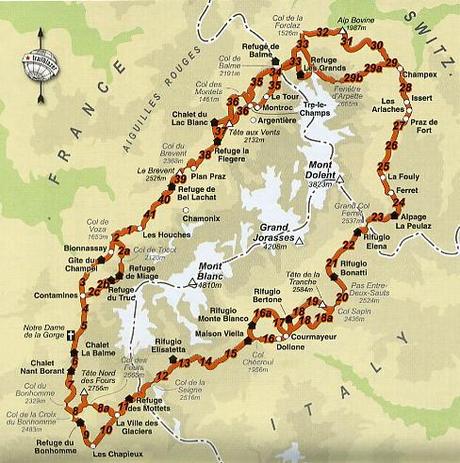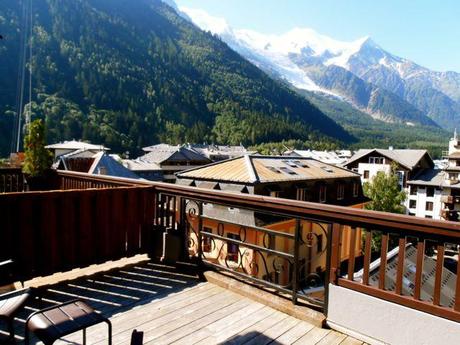The Tour du Mont Blanc (TMB) is listed as not only one of Europe’s classic hikes, but one of the best in the world!

The 160km, 8000+ elevation gain hike around the highest peak (4810 m) in Western Europe is a classic. Having just completed it through France, Italy and Switzerland, I can highly recommend it. Although you don’t actually go to the peak itself (that involves mountaineering), it’s tough. It will challenge you both physically and mentally, but with a little bit of planning you can choose how much you want to be challenged.
There are a variety of ways that you can hike the TMB.
There are guided hikes, some where you are accompanied by a donkey, like Coco, pictured below in which you are able to off load 7 kg of gear to him. I kept running into him along the way on our tour and rewarded him for his efforts with fruit – even though he wasn’t carrying any of my gear. What can I say? He has the name name as my cat, so I took to him immediately, plus I love donkeys!

Coco, carried 7kg of each of his group’s stuff. He’s not fond of tomatoes, but likes peaches and apples.
There are also self-guided treks, in which a tour operator consults with you or makes all the arrangements for you. Lastly, you can plan it all yourself as we did.
So how do you plan your own Tour du Mont Blanc?
I recommend that you plan it by using a combination of this site, Tour of Mont Blanc: Complete Two-Way Trekking Guide Book by Cicerone Guides. (I had bought another book, but after seeing this book, it was much better than the one I had) and a good map of Mont Blanc.

Map of the Tour du Mont Blanc 160km circuit.
Choose Your Starting Point for the TMB:
We started in Chamonix, known as the “Capital of Extreme” for all of its climbing, mountaineering and rafting activities, but the traditonal starting point and where most people that we met started in the nearby village of Les Houches. Travel tip: If you do decide to start in Les Houches, ensure you buy everything you need in Chamonix first. We walked from Chamonix to Les Houches and had to take the bus back to Chamonix again to buy an iPhone cable since I couldn’t find one in Les Houches – it’s really small.
Choose the direction you will trek the TMB:
The traditional way is to do it counter-clockwise which is how we did it. The apparent advantage of doing it clockwise (I’ve only done it counter-clockwise) is that you will be going against the flow. You will also want to choose a different starting point, like Champex if you decide to do it clockwise. This will help you ease into the steep climbs.
Use a combination of the TMB site, book and map to plan each day.
Don’t start by saying that you will do the trek in so and so many days. Plan each day according to what seems reasonable to you. The TMB site, shows you the availability of the refuges (mountain huts) and how long it takes to hike to the other hut. You’re also able to book the huts directly through their site. The disadvantage to the TMB site though is that it doesn’t provide the elevation gain, nor the distance, which is where the book comes in. Note: If you are choosing a longer trek that often means going up two separate cols/mountain passes. Keep in mind that you will likely be much slower later on in the day when your legs are already tired, then when you first started out. It’s also a good idea to plan your route out on a map, so that you can choose huts that are en route to where you’re going and not out of your way.
Allow Additional Time for Breaks/Stops/Slower Hiking:
The times mentioned in the book and on the TMB site do not include breaks/stopping for route finding etc. Nor do they account for going slower on a long day. If a 6 hour time is mentioned, you probably want to calculate for somewhere between 7-8 hours. We had one really long day which was calculated as just over 9 hours of hiking, but it took us over 13 1/2 hours (including a breakfast and lunch stop). A lot of it was because by the time we finally hit the second bit of elevation, we were already 22km into our hike and climbed the 700m of elevation at a tortoise pace.
Inform Refuges Prior of any Dietary Preferences:
I have a gluten allergy and informed all of the refuges before we left. It wasn’t a problem, when they were informed, except at breakfast where typically just bread was served. None of the refuges had gluten-free bread (which was fine with me), so I asked for a piece of fruit instead. If you have any special dietary needs it’s worth giving them a heads up prior since dinner is one standard meal unless you make special arrangements.
To Reserve or Not to Reserve Refuges on the TMB?:

Relaxing at Fioux Refuge and enjoying the views of Mont Blanc.
We reserved all of our refuges in advance. We wanted to enjoy our holiday and not be on our phone each day trying to call ahead to see if there was space. We also didn’t want to just show up and find out there was no space left. The disadvantage of this is that it allowed us no flexibility. The advantage was that we never had to worry about finding a place to sleep.
As it turned out, all of the refuges we stayed at, did have space, so reservations may not always be necessary, but often the only space left was in a dormitory and we preferred to sleep in private rooms when possible. Travel tip: If you don’t have reservations for a refuge, then try to get an early start and arrive early, before it does come full with other hikers who have the same idea.
Pamper Yourself at the Beginning and End of Your TMB Trek

View of Mont Blanc from our room at Boutique Hôtel Le Morgane in Chamonix.
We stayed at the Hôtel Les Aiglons, Resort & Spa the night before our trek and at Boutique Hôtel Le Morgane on the last day of our trek. Both are four star eco hotels in Chamonix, complete with a spa! After staying in refuges it was pure bliss. We sat on our huge patio enjoying the killer views of Mont Blanc, as we rested our blistered, aching feet. Trust me, on the final day, you’ll likely be tired, so it’s worth a bit of a splurge!
So How Did Planning our Own TMB Trek Work Out?
Overall it worked out really well for us. We did it in 8 days (between 7-12 days is recommended). We did have several long days, which were manageable, but our 13 1/2 hour day was way too long. I was THISCLOSE to calling a taxi for the last 3km, but sustained, or rather J.P. wisely prevented me. It would have been nice to have had an extra day or two to reduce the amount of hiking we did on some days. I also wish I would have used the book mentioned above instead of mine, which didn’t include elevation gains or distances.


